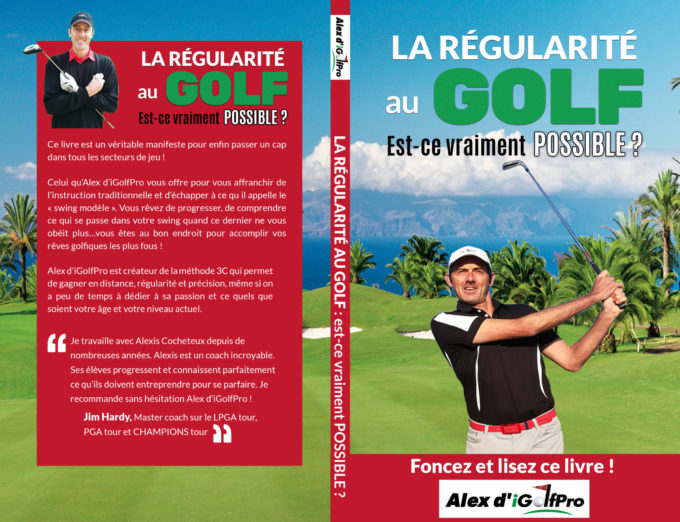Posted on January 4, 2020 in News.
Alexis Cocheteux: "The phase which precedes the swing is essential"
Former player of the Alps Tour, Alexis Cocheteux has been teaching golf since 2001 and publishes numerous videos on the Internet. In his book « Regularity in golf: is it really possible? ", he answers the question that torments us all. Interview.
You have traveled and taught a lot in Malaysia, Sardinia, Tunise, Lille, Provence or even Marrakech, where you are now located. What are the most common flaws in amateur players around the world?
Alexis Cocheteux: I would say that a lot of amateur golfers tend to look for info right and left, trying a little bit of everything, hoping to find a quick fix. After that, it also depends on the level of the players. For example, beginners tend to believe that it is important not to move your head during the swing. More experienced players think that to gain distance, it suffices to accentuate the delay effect by turning the pelvis even earlier during the downswing. They seek too many technical keys in the body domain, while the path of the arm and the club is also important and almost always neglected.
In your book, you talk about the 3C method. No relation to the Club des Croqueurs de Chocolat I suppose…
AC: Not really (laughs). The three Cs, like constancy, contact and concentration. Consistency in golf is the sinews of war, if I may say so. The contact of the ball is what makes us vibrate, what perhaps gives us the most pleasure. Finally the last C is the concentration, which must be maintained for several hours and 18 holes.
You also talk a lot about biomechanics ...
AC: One of the bases of my teaching is to use biomechanics to improve contact with the ball and gain regularity and enjoyment of the game. It is about understanding how the body works to advance players and adapt their swings, depending in particular on the effects they tend to give to their balls and not the aesthetic aspect of the swing. This allows you to progress much more quickly without having to regress. Let us never forget that every swing is unique and that the model swing, as it is always sold to us, is dead. The idea in the end is to switch from “practice” mode to “play on a course” mode, to know how to let go and have a natural swing.
Is the famous letting go and the mind the key?
AC: Yes, although the mind has many possible meanings. The emotional aspect, the phase that precedes the action, in this case the swing, is essential. There are players who will have no trouble hitting a 6 iron on a par 3. Add a water hazard in front of this same par 3 and it is not the same story at all, even though it is the same distance and same club. It immediately becomes more inhibiting. I worked with Henry Boulton, routine expert on the PGA Tour and mental coach of Justin Rose and Jason Day. He brought the latter from the 65e in the first place in the world. We use in particular a focusband, a small band with three electrodes that measures the degree of letting go and focusing. The secret is to focus on narrow areas and visualize our next move in order to occupy the brain and thus better let go. But here too, focus and routine must be personalized. Look at Jason Day's routine and concentration before performing a shot, it's impressive ...
In your book, you also mention grip pressure, which is essential and must vary according to the profiles of the players.
AC: It is generally said that to hold a club, it is enough to use the last three fingers of each hand. This is valid for half of the players, those who have a posture with the weight forward, like Rory McIlroy or Tiger Woods for example. A guy like Tony Finau, who has a more seated, more anchored posture, will on the contrary have an interest in tightening his club especially with his index finger (the pliers), a bit like a trigger. Like tennis, depending on whether you adopt a bent posture or a more upright posture on return from serve, the biomechanics are not the same, you should not use the same technical springs. The spring and the supports in the golf course are crucial to gain regularity and distance.
What about putting?
AC: In putting, classical teaching recommends not to over tighten the club. However, biomechanical tests show that if you have a too soft grip, the face of the putt will tend to open up too much when you do not center the ball correctly. It is ideal to put pressure on the left thumb of the upper hand, as the face of the putter moves much less if the ball is off-center.
I have to conclude by asking you THE question: regularity in golf, is it really possible?
AC: No, because the machine is doomed to go wrong. But golfing autonomy yes, it is possible. Because the machine always goes wrong in the same way ...
To know more : https://alex.i-golf-pro.com/commande2-livre/
Interview by Franck Crudo
Thomas Haza, appointed director of Murtoli Golf Links
Another Swing, eco-responsible partner of the LeClub Golf network
Peter Baker, double triumph at the MCB Tour Championship, Remesy 4th









